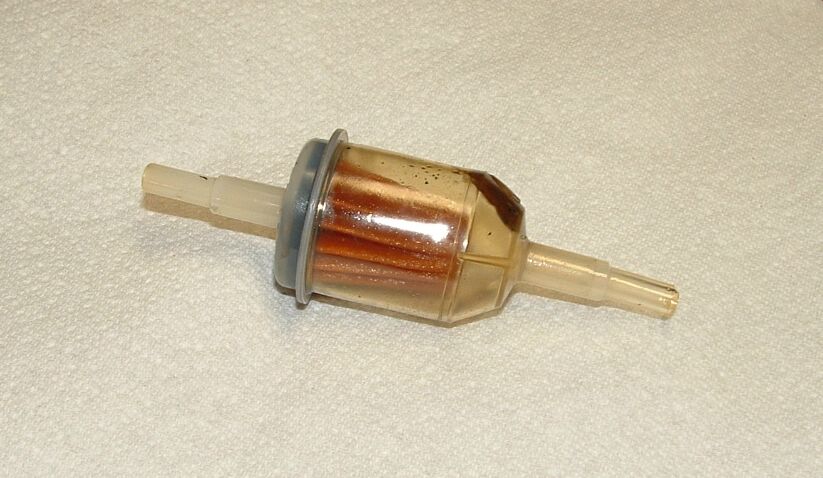|
||
|
|
Fuel Filter ServiceWARNING: Gasoline is extremely flammable, so take extra precautions when you work on any part of the fuel system; such as -
Note: In cars with the fuel filter located below the fuel tank under the car, replacement is easier if the fuel tank is empty. Try to schedule fuel filter replacement when the tank is nearly empty. For standard Bugs with a fuel filter inside the tank, the tank MUST be empty, as you will have to remove the gas tank to get at the filter. Often times poor performance (or NO performance!) can be traced to the fuel filter, which is located under the fuel tank. Rob had an interesting experience in this regard - When I examined the filter it looked okay, and when I blew backwards though it I had no trouble blowing air through it. But I discovered that the thing was apparently partially blocked - enough that only a trickle of fuel could get through. So giving it a rest allowed what was in the pump to leak through and partly fill the bowl in the carburetor, then as I drove, the trickle was less than the fuel use and eventually the car conked out again. Lesson learned -- When in doubt, replace the filter! It can cause you serious headaches if it gets clogged or even partially clogged. The filter is very inexpensive (your local auto parts store will probably have them) and relatively easy to replace.
 Clogged Fuel Filter
 Clogged and New Fuel FiltersProcedure (Super Beetle)Note: In the Super Beetle the fuel filter is located under the fuel tank in the right-front wheel well. This procedure includes removal of the right front wheel. Dave has found that the filter can be easily accessed by jacking the front of the car up and supporting it on jack stands.
Note: You ARE going to spill some gas - a lot if you're not careful!! Be prepared with a flat metal pan to put under the working area (before you begin work on the fuel filter!), a quart jar to catch gas as you break connections, a couple of nail punches, and lots of rags. Note: We formerly recommended using sharpened pencils to plug the fuel lines when they are removed from the filter. This will work okay if you are careful, but it is easy to break off the end of the pencil in the fuel line and not realize it. Poor performance will result. Note: Dave has tried various means of clamping the hoses, with only marginal success, lots of frustration, and lots of spilled gas. He has found that the following method is easiest and results in the least amount of gas spillage. Note: You will probably need to build a little pedestal out of 2x4's or something to set the jar on, as the removed line won't extend all the way down to it. There won't be much gas spillage in any event, since with the front of the car raised the fuel line is sloping toward the rear of the car. Note: Carefully examine the condition of the fuel line. It can become hard and brittle over time, making it very difficult to insert the nozzle on the fuel filter into it. Dave found the end of the line to be cracked, so he cut it back about half an inch. Then he had a VERY difficult time getting the fuel filter into it. He had to ream it out repeatedly with the nail punch, all the while spilling gas all over the place. If this happens to you, replacement of the fuel line from the tank down to the filter is in your future. See our Fuel Tank Removal and Refurbishment Procedure for details. Note: It is important to attach the line from the fuel tank to the filter as quickly as possible, as there may be up to ten gallons of head behind this line! Note: Note the direction of flow carefully. It's easy to get the hoses mixed up and install the filter backwards. Fuel Filter in the Engine CompartmentPlease note: If you have a filter between the fuel pump and the carburetor, MOVE IT! The brass inlet pipe in the top of the carburettor is just a push fit in the carb metal, and the extra weight of a fuel filter jiggling on that fuel line CAN be enough to work the inlet pipe loose, and if that happens, you'll have fuel sprayed all over your hot engine. A toasted bug it not a pretty site! Any fuel filter in the engine bay should be BEFORE the fuel pump, so it gets nice clean fuel to work with, and that inlet pipe for the carburettor has no extra weight hanging from it. While you're looking at fuel filters, clean the filter screen in the fuel pump (if there is one - usually only on standard Bugs with the old style upright rectangular pumps), as follows -
|
||
|
|

